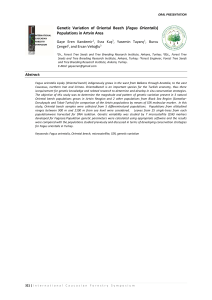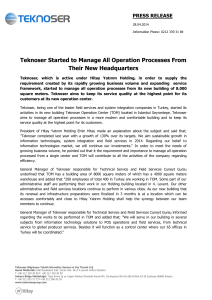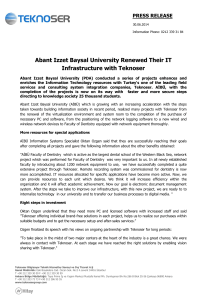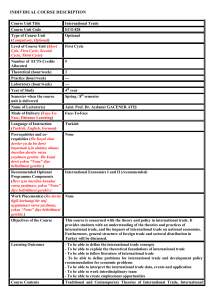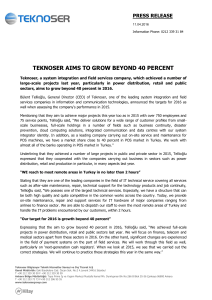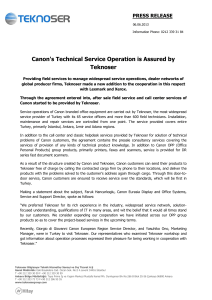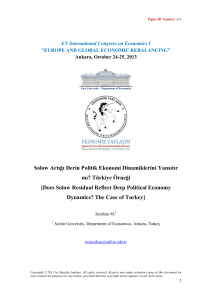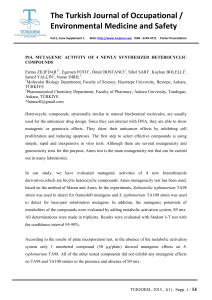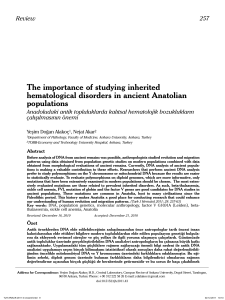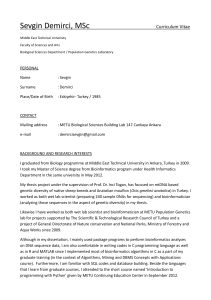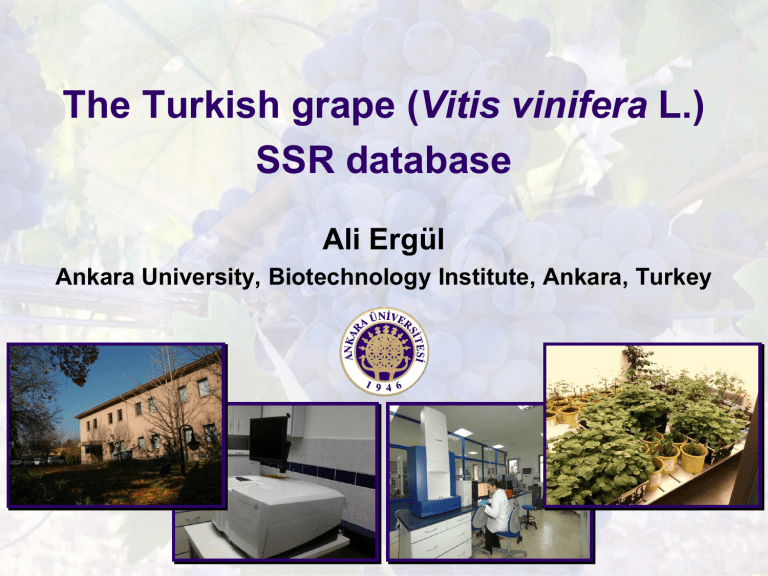
The Turkish grape (Vitis vinifera L.)
SSR database
Ali Ergül
Ankara University, Biotechnology Institute, Ankara, Turkey
Introduction
Turkey has a rich grapevine (Vitis vinifera L.)
germplasm.
Recently, a grape germplasm repository called the
“National Grapevine Germplasm Vineyard” has been
established at the Institute of Viticulture in Tekirdağ.
This collection currently contains 1100 grapevine
accessions collected from different geographical
regions over more than 30 years.
To date very few studies have been carried out for
genetic characterization of this grape germplasm at
the molecular level.
Objectives
SSR based identification of national
grape germplasm
Elimination of potential redundancy in
the germplasm
Identification of genetic characteristics
of Turkish grape populations
Establishment of an SSR database to
facilitate data dissemination
Materials & Methods
Plant material:
A total of 1115 grape
cultivars obtained from
the National Grapevine
Germplasm Vineyard at
the Institute of Viticulture
in Tekirdağ (1065
genotypes), and the
Eastern Anatolia
Horticultural Research
Institute in Erzincan (50
genotypes) were analyzed
Tekirdağ
Erzincan
National Grape Germplasm - Tekirdağ
Populations and the number of samples(N) in each population
No
Grape Regions
N
1
South East Anatolia (SEA)
67
2
Mediterranean (MED)
133
3
Aegean (AEG)
94
4
Marmara (MAR)
112
5
Black Sea (BLA)
158
6
Central Anatolia (CA)
118
7
National Collection Eastern
Anatolia (EA)
26
8
East Anatolia2(EAHRI) (EA2)
50
No
Grape groups
N
No
Grape Groups
N
9
Parmak (PAR)
33
20
Kabarcık (KAB)
8
10
Çavuş (ÇAV)
25
21
Kuşüzümü (KÜ)
9
11
Razakı (RAZ)
10
22
Narinci (NAR)
6
12
Muskat (MUS)
13
23
Bulut (BUL)
15
13
Tilki Kuyruğu (TK)
16
24
Dimrit (DIM)
24
14
Keçi Memesi (KM)
13
25
Gemre (GEM)
12
15
Amasya (AMA)
11
26
Beyazüzüm (BÜ)
22
16
Büzgülü (BÜZ)
15
27
Siyahüzüm (SÜ)
85
17
Karagevrek (KG)
4
28
Pembeüzüm (PÜ)
4
18
Devegözü (DG)
21
29
Unknown (UNK)
9
19
Yediveren (YV)
6
Total
1115
29 populations
or
sub-groups
Methods
DNA was extracted from grape leaf tissue (Lefort et al.
1998).
SSR markers used: VVS1 and VVS2 (Thomas and Scott,
1993), VVMD5, VVMD7, VVMD21, VVMD24, VVMD27,
VVMD28, VVMD31 and VVMD32 (Bowers et al., 1996,
1999), ZAG 21, ZAG47, ZAG62, ZAG64, ZAG79,
ZAG83 and ZAG112 (Sefc et al., 1999), VMC2h4,
VMC2c3 (Goto-Yamamoto et al., 2006), VVIh54, VVIb01
(Merdinoglu et al., 2005).
Methods
DNA isolation
PCR amplification
Analysis of SSR data
Forward primers of each primer
pair labeled with WellRED
fluorescent dyes (Proligo,
Paris, France).
Cabernet Sauvignon, Pinot Noir
and Merlot included as
reference cultivars.
Analyses repeated at least twice
to ensure reproducibility.
Beckman CEQ 8000 DNA Capillary
electrophoresis
Methods
Genetic analyses:
Factorial Correspondence Analysis performed on the data to find
the presence of any population structure among grape populations
by using Genetix4.
Principle component analysis applied to SSR data to find out any
possible clusters using NTSYS-pc.
The NEI 1972 genetic distance estimated and the NJ tree
constructed using NTSYS-pc.
Genotypes analyzed using the program Structure 2.3 to determine if
any populations structure present in grape populations.
F statistics and linkage disequilibrium estimated using the same
software.
Results and Discussion
5
20
D
VV 7
M
D
21
VV
M
D
24
VV
M
D
27
VV
M
D
2
VV 8
M
D
31
VV
M
D
32
Z
A
G2
1
Z
A
G4
7
Z
A
G6
2
Z
A
G6
4
Z
A
G7
9
Z
A
G8
3
Z
A
G1
1
VM 2
C2
H
VM 4
C2
C3
VV
IH
54
VV
IB
01
D
2
20
VV
M
VV
M
1
15
VV
S
VV
S
Number of alleles in each locus
30
28
25
18 18
11
16 16
13 13 12
13
16
14 15 13
16 16
11
16 17
11
10
5
0
Expected and Observed Heterozygosity
over all loci and all populations
Sub-groups
HSobs = 0.6843
HS(nc)exp = 0.7100
Total
HTobs = 0.7391
HT(nc)exp = 0.7400
GST = 0.0742
GST(nc) = 0.0405
Differentiation
(moderate)
Factorial Correspondence Analysis Individuals
Factorial Correspondence Analysis Populations
Principle Component Analysis Populations
Nei (1972) Genetic Distance Between Grape
Populations
NJ Dendrogram - Populations
Pairwise Fst Values of Grape Populations
Gene flow (nm) between grape populations as determined by the nm values
estimated from the genetic differentiation among populations (Fst)
Nm = (1-Fst)/4*Fst
greater the Fst values smaller the nm values
Gene Flow (nm) Among Grape Populations
Structure Analysis (k=25)
Çavuş
Büzgülü
Why Çavuş and Büzgülü populations are more homogenous?
biology of fertilization
no natural dispersion (unmatured seeds)
HW-LD
Hardy-Weinberg (HW) equilibrium in grape
populations and Linkage Disequilibrium (LD)
between loci tested.
Some deviations from Hardy-Weinberg
equilibrium for some of the loci found
Significant association between loci detected
Number of Identical, Synonymous,
homonymous
Homonymous grapes : 143
Synonymous grapes : 68
Identical grapes
:107
Clonal relationship
The number of grape pairs
Genetic similarity (%)
93
92
102
95
68
97
Conclusions
Out of a total of 1115 grapes analyzed, 854
cultivars were identified apart from the
synonym, homonym and identical cases.
Studies on the development of the
associated SSR database are currently
ongoing.
The data reported here can be directly
compared with other studies in other
countries that used these SSR markers on
grape.
Acknowledgements
This study was supported by the
Scientific and Technical Research
Council of Turkey (TUBITAK) and the
Turkish Ministry of Agriculture and
Rural Affairs (Project number: 105 G
078).
Research Group
Dr. Hasan Çelik
Dr. Gökhan Söylemezoğlu
Ankara University, Faculty of Agriculture,
Department of Horticulture, Ankara, Turkey
Dr. Kemal Kazan
Commonwealth Scientific and Industrial
Research Organization (CSIRO), Plant
Industry, Australia
Research Group
Dr. Yılmaz Boz, A. Semih Yaşasın
Dr. Cengiz Özer
The Ministry of Agriculture and Rural
Affairs, Institute of Viticulture, Tekirdağ,
Turkey
Melike Bakır, Pelin Çelikkol,
Nur Yıldırım, Canan Yüksel
Ankara University, Biotechnology
Institute, Ankara, Turkey
Thank you…

